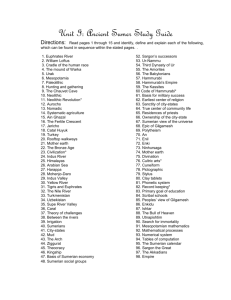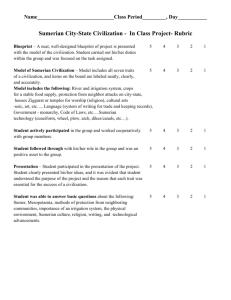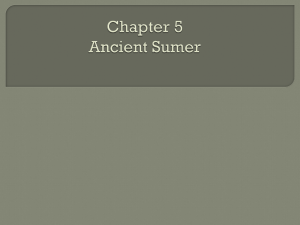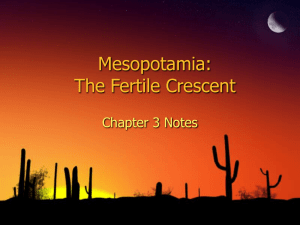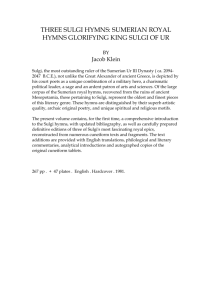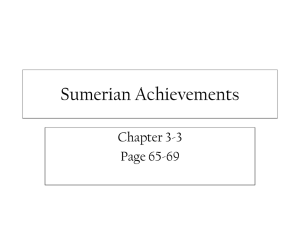the genealogies of gen 5 and 11 and their
advertisement
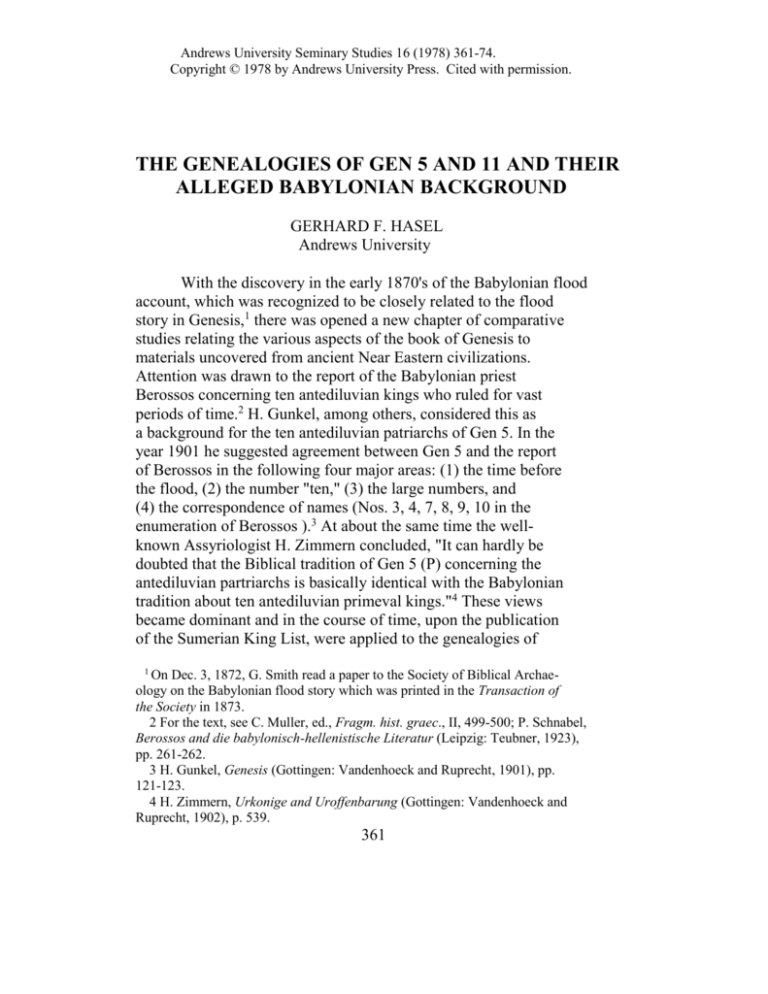
Andrews University Seminary Studies 16 (1978) 361-74. Copyright © 1978 by Andrews University Press. Cited with permission. THE GENEALOGIES OF GEN 5 AND 11 AND THEIR ALLEGED BABYLONIAN BACKGROUND GERHARD F. HASEL Andrews University With the discovery in the early 1870's of the Babylonian flood account, which was recognized to be closely related to the flood story in Genesis,1 there was opened a new chapter of comparative studies relating the various aspects of the book of Genesis to materials uncovered from ancient Near Eastern civilizations. Attention was drawn to the report of the Babylonian priest Berossos concerning ten antediluvian kings who ruled for vast periods of time.2 H. Gunkel, among others, considered this as a background for the ten antediluvian patriarchs of Gen 5. In the year 1901 he suggested agreement between Gen 5 and the report of Berossos in the following four major areas: (1) the time before the flood, (2) the number "ten," (3) the large numbers, and (4) the correspondence of names (Nos. 3, 4, 7, 8, 9, 10 in the enumeration of Berossos ).3 At about the same time the wellknown Assyriologist H. Zimmern concluded, "It can hardly be doubted that the Biblical tradition of Gen 5 (P) concerning the antediluvian partriarchs is basically identical with the Babylonian tradition about ten antediluvian primeval kings."4 These views became dominant and in the course of time, upon the publication of the Sumerian King List, were applied to the genealogies of 1 On Dec. 3, 1872, G. Smith read a paper to the Society of Biblical Archaeology on the Babylonian flood story which was printed in the Transaction of the Society in 1873. 2 For the text, see C. Muller, ed., Fragm. hist. graec., II, 499-500; P. Schnabel, Berossos and die babylonisch-hellenistische Literatur (Leipzig: Teubner, 1923), pp. 261-262. 3 H. Gunkel, Genesis (Gottingen: Vandenhoeck and Ruprecht, 1901), pp. 121-123. 4 H. Zimmern, Urkonige and Uroffenbarung (Gottingen: Vandenhoeck and Ruprecht, 1902), p. 539. 361 362 GERHARD F. HASEL both Gen 5 and 11.5 E. A. Speiser's commentary, which is particularly noted for sensitivity in the relationship to ancient Near Eastern backgrounds, suggests that the biblical genealogies are dependent upon a Mesopotamian source.6 1. New Ancient Near Eastern Data The year 1923 was the beginning of a new era as regards the alleged Babylonian background of Gen 5 and 11, because S. Langdon published in that year the first cuneiform text of what is now known as the Sumerian King List.7 About a decade and a half later T. Jacobsen produced the standard publication, entitled The Sumerian King List (1939).8 These cuneiform materials surprisingly supported much of the information known from Berossos but at the same time brought about significant corrections. Since 1952 a steady stream of additional texts and fragments of the Sumerian King List has come to light and seen publication.9 5 G. von Rad, Genesis: A Commentary (Philadelphia: Westminster, 1961), p. 69; R. A. Bowman, "Genealogy," IDB 2: 363. See also the assessment of M. D. Johnson, The Purpose of the Biblical Genealogies (Cambridge: University Press, 1969), pp. 28-31. 6 E. A. Speiser, Genesis, AB, p. 41. 7 S. Langdon, "The Chaldean Kings Before the Flood," JAOS 42 (1923): 251-259. 8 T. Jacobsen, The Sumerian King List, Assyriological Studies 11 (Chicago: University of Chicago Press, 1939). Recent translations are provided by A. L. Oppenheim in ANLT, pp. 265-266; and most recently by H. Schmokel in Religionsgeschichtliches Textbuch Zum Alten Testament, ed. W-V. Beyerlin (Gottingen: Vandenhoeck and Ruprecht, 1975), pp. 113-114 (hereafter cited as RTAT). 9 F. R. Kraus, "Zur Liste der altcren Konige von Babylonien," ZA 50 (1952): 29-60; M. B. Rowton, "The Date of the Sumerian King List," JNES 19 (1960): 156-162; J. J. A. van Dijk, "Die Tontafeln arts dem res-Heiligtum," Vorlaufiger Bericht uber die von der Notgeneinschaft der deutschen Wissenschaft in Uruk-Warka unternommenet Ausgrabungen 18 (1962): 43-52; S. N. Kramer, The Sumerians (Chicago: University of Chicago Press, 1963), pp. 328-331; J. J. Finkelstein, "The Antediluvian Kings: A University of California Tablet," JCS 17 (1963): 39-51; W. W. Hallo, "Beginning and End of the Sumerian King List in the Nippur Recension," JCS 17 (1963): 52-57; W. G. Lambert "A New Look at the Babylonian Background of Genesis," JTS 16 (1965): 287300, esp. 292-293; H. J. Nissen, "Fine ncue Version der sumerischen Konigsliste," ZA 57 (1965); 1-5; M. Civil, "Texts and Fragments," JCS 15 (1961): GENEALOGIES OF GEN 5 AND 11 363 The Sumerian King List is now available in more than one version, with significant differences in the sequence of cities and of kings and their lengths of reign. These facts have made it evident that a "canonical" form of the Sumerian King List was never in existence. Such texts as the genealogy of Hammurapi and the rulers of Lagas,10 the Assyrian and Babylonian King Lists,11 and cuneiform chronicles throw new light on the respective literary genres12 and the relationship of the biblical genealogies to their ancient Near Eastern analogues.13 2. Comparison of Gen 5 and 11 with the Sumerian King List The new set of cuneiform data relating to the Sumerian King List and the information given by Berossos provide new insights into the alleged Babylonian background of the genealogies of Gen 5 and 11. There remains a formal similarity between the 79-80; W. G. Lambert and A. R. Millard, Atra-hasis. The Babylonian Story of the Flood (Oxford: Oxford University Press, 1969), p. 25; W. W. Hallo, "Antediluvian Cities," JCS 23 (1970): 57-67. 10 J. J. Finkelstein, "The Genealogy of the Hammurapi Dynasty," JCS 20 (1966): 95-118; E. Sollberger, "The Rulers of Lagas," JCS 21 (1967): 279-291; W. G. Lambert, "Another Look at Hammurapi's Ancestors," JCS 22 (1968): 1-2. 11 B. Landsberger, "Assyrische Konigsliste and 'Dunkles Zeitalter,' " JCS 8 (1954): 31-45, 47-73, 106-133; I. J. Gelb, "Two Assyrian King Lists," JNES 13 (1954): 209-230; R. Borger, Einleitung in die assyrischen Konigsinschriften. Erster Teil, 2d ed. (Leiden: Brill, 1961), pp. 9-xx; A. Poebel, The Second Dynasty of Isin According to a New King-List Tablet, Assyriological Studies 15 (Chicago: University of Chicago Press, 1955); ANET, pp. 2711-274, 564-566; A. K. Grayson, "Assyrian and Babylonian King Lists: Collations and Comments," lisan nzithurti. Festschrift fur Wolfram Freiherr von Soden, ed. M. Dietrich and W. Rollig (Kevelaer: Butzon and Berger, 1969), pp. 104-118; R. R. Wilson, Genealogy and History in the Old Testament: A Study of the Form and Function of the Old Testament Genealogies in their Near Eastern Context (Ph.D. dissertation; Yale University, 1972), pp. 109-133. 12 W. Rollig, " Zur Typologie and Entstehung der babylonischen and assyrischen Konigslisten," Alter Orient and Altes Testament, 1 (Kevelaer: Butzon & Berger, 1969): 265-277. 13 A. Malamat, "King Lists of the Old Babylonian Period and Biblical Genealogies," JAOS 88 (1968): 163-173; T. C. Hartman, "Some Thoughts on the Sumerian King List and Genesis 5 and 11B," JBL 91 (1972): 25-32; R. R. Wilson, "The Old Testament Genealogies in Recent Research," JBL 94 (1975): 169-189. 364 GERHARD F. HASEL genealogies in Gen 5 and 11 and the Sumerian King List in terms of listings14 divided by a flood. The listings of antedilivian and postdiluvian rulers in the major recension of the Sumerian King List are separated by but one sentence: "The Flood swept thereover [the earth]."15 The genealogies in Gen 5 and 11 are also separated, but by extensive and various materials: (1) the marriage of the sons of God with the daughters of men (6:1-4), (2) an intricate story of the flood (6:5-9:7), (3) the universal covenant (9:8-17), (4) the Table of Nations (10:1-32 ), and (5) the story of the tower of Babel (11:1-9) . There are a number of significant areas where comparison may be made between the genealogies of Gen 5 and 11 and the Sumerian King List from Old Babylonian times. It is helpful and revealing to develop these areas as follows 1. Semitic Names versus Sumerian Names. The claim of the correspondence of the names between the listings by Berossos and Gen 5 could not be sustained with the discovery of cuneiform materials relating to the listing of Berossos. H. Zimmern himself acknowledged that "the beautiful combinations (with the names in Gen 5) ... have come to a merciless end."16 The names turned out to be Sumerian instead of Semitic. J. J. Finkelstein has recently noted, "Certainly, the earlier attempts to harmonize the Biblical and Mesopotamian names proved utterly futile."17 The reason for this radical change from the early position of Gunkel and others rests in the fact that no less than six different cuneiform versions are now at hand for comparative purposes on the basis of which the Greek version of Berossos could be reassessed. 14 Hartman, "Some Thoughts." p. 26. Jacobsen, Sumerian Kind List, p. 77. Cf. ANET, p. 265; RTAT, p. 114. Research into the origin of the Sumerian King List has led to the conclusion that the list of kings before the flood and the list of kings after the flood, were originally separate. 16 H. Zimmern, "Die althabylonischen vor- (und Mach-) sintflutlichen Konige nach neueren Quellen," ZDMG 78 (1924): 19-35. Similarly also Langdon, "The Chaldean King List Before the Flood," p. 257. 17 Finkelstein, "The Antediluvian Kings," p. 50, n. 41. 15 GENEALOGIES OF GEN 5 AND 11 365 All of these versions agree on the Sumerian origin of the names and the distance from those in Gen 5 and 11. 2. Longevity versus Reigns. C. Westermann noted correctly that among the differences between Gen 5 (and 11) and the Sumerian King List is that the former provides the numbers in terms of "years of life" whereas the latter gives the numbers in terms of "years of reign."18 The distinction between longevity and rulership is an important one. Each has its own independent functions in the context in which it appears. 3. Line of Descent versus Succession of Kings. Gen 5 follows the standard line of descent formula, "When PN1 had lived x years, he became father of PN2. Then PN1 lived y years after he became the father of PN2 and he had other sons and daughters. So all the days of PN1 were z years, and he died." Gen 11 employs the same line of descent formula with the exception of the last sentence. At times additional information is inserted in Gen 5 and 11. Both Gen 5 and 11 have "a descending type of genealogy"19 in which the generations are traced in a supposedly unbroken line of descent from the first person mentioned to the last one. The Sumerian King List, on the other hand, lists kings and seeks to trace a succession of them in various cities. The flexible pattern employed is as follows: "In CN, RN1, ruled x years, RN2, ruled x years, RN3 ruled x years, x king(s) ruled y years." One antediluvian section concludes : "There are x (5) cities, x (8) kings ruled x (241,200) years. Then the flood swept thereover." The succession of kings with their reigns differs radically from the line of descent genealogy in Gen 5 and 11, which is totally unconcerned and uninterested in kings, dynasties, and cities. 4. Lengths of Life versus Lengths of Reign. The relatively high figures of life-spans of Gen 5 which nevertheless do not ever 18 C. Westermann, Genesis (Neukirchen-Vluyn: Neukirchener Verlag, 1971), p. 472. 19 T. C. Mitchell, "Genealogy," New Bible Dictionary: Revised (Grand Rapids, Mich: Eerdmans, 1965), p. 457. 366 GERHARD F. HASEL exceed a single millennium "turn out to be exceptionally moderate by comparison "20 with the Sumerian King List where the respective lengths of reigns of the kings run from 18,600 years for king Ubartutu (WB 444)21 to 72,000 for kings Alalgar, [. . .] kidunnu, and Enmenduranna.22 In many instances there are great divergencies regarding the lengths of reigns and the number of kings in the respective witnesses to the Old Babylonian tradition. The following comparison may be helpful: WB 444 Alulim 28,800 Alalgar 36,000 Entnenluanna 13,200 Enmengalanna28,800 Dumuzi 36,000 Ensipazianna 28,800 Enmendurunki 21,000 Ubarututu 18,600 Total: Kings-8 Years-241,200 WB. 62 UCBC 9-1x19 Alulim 67,200 Alulim 36,000 Alalgar 72,000 Alalgar 10,800 ... kidunnu72,000 Ammeluanna 36,000 .. alinuna 21,600 En sipazianna 13,200 Dumuzi 26,800 Dumuz,i 36,000 Enmendurauna21,600 Enmeduranki 6,000 Ensipaizianna 36,000 Ubartutu ? Enmenduranna 72,000 [Ziusudra?] 16,000+ Suruppak 28,800 Ziusudra 36,000 Total: Total: Kings-10 Kings - 7 [or 8] Years-456,000 Years-186,000+ BEROSSOS Aloros 36,000 Alaparos 10,800 Amelon 46,800 Amenon 43,200 Megalaros 64,800 Daonos 36,000 Euedorachos 64,800 Amempsinos 36,000 Otiartes 28,800 Xisuthros 64,800 Total: Kings - 10 Years-432,000 One notices the striking differences in total years of reigns in some texts. The total years are exceeded by 200,000 in some recensions. Of course, these fabulous lengths of reigns are not trustworthy.23 It has been thought that there has been use of some kind of scheme built on the Sumerian duodecimal system,24 where all figures can be divided by 1 SAR = 3,600 (60 x 60) or through a sixth of it (600), or other systems.25 In view of this, "It would seem fair to conclude that no significance at all is to be 20 Speiser, Genesis, p. 42. ANET, p. 265. 22 Finkelstein, "The Antediluvian Kings," p. 49. 23 R. D. Tindel, "Mesopotamian Chronology," IDB Sup (1976), p. 161. 24 See the attempt at unraveling the system by` J. R. Garcia, C.M.F., "Las genealogias genesi,:uas y la cronologia," Estudios Biblicos 8 (1949): 337-340; J, Meysing, "Contribution a 1'etude des genealogies bihliques: Technique de la composition des chronologies bahyloniennes du deluge," RechSR 39 (1965): 209-229. 25 RTAT, p. 113, n. 107. 21 GENEALOGIES OF GEN 5 AND 11 367 attributed to the total number of years given for the entire antediluvian period in the different texts [of the Sumerian King List]."26 5. Ten Antediluvian Ancestors versus Seven-to-Ten Kings. As recently as 1965 the Assyriologist W. G. Lambert pointed to the number of "ten long-lived patriarchs from Adam to Noah" that span the time to the flood as a point of borrowing on the part of the Hebrews from Mesopotamia.27 However, the major recension of the Sumerian King List (WB 444) contains only eight and not ten kings.28 One text contains only seven kings (W) and another (UCBC 9-1819) either seven or eight,29 whereas a bilingual fragment from Ashurbanipal's library has but nine kings .30 Berossos and only one ancient tablet (WB 62), i.e. only two texts (of which only one is a cuneiform document), give a total of ten antediluvian kings.31 On the basis of the cuneiform data it can no longer be suggested that the Sumerian King List contained originally ten antediluvian kings after which the biblical genealogies were patterned. In addition, the supposedly unbroken line of descent in Gen 5 is in stark contrast to the concurrent or contemporaneous dynasties of the Sumerian King List.32 We must also note that Gen 11 lists ten postdiluvians from Shem to Abraham whereas the Sumerian King List enumerates thirty-nine kings. 6. Tracing of Ancestors versus Unification of the Land. The basic ideology of Gen 5 and 11 appears to be to trace the ancestors in a supposedly unbroken line of descent (i.e. linear genealogy) from the first man (Adam) at creation to the last man (Noah) 26 Finkelstein, "The Antediluvian Kings," p. 51. Lambert, "The Babylonian Background of Genesis," pp. 292-293. 28 Jacobsen, Sumerian King List, p. 77; ANET, p. 265; RTAT, p. 114. 29 Finkelstein, "The Antediluvian Kings," p. 45; Van Dijk, "Die Tontafeln," pp. 44-45 and P1. 27. 30 Lambert, "The Babylonian Background of Genesis," p. 292; RTAT, p. 113, n. 106. 31 Finkelstein, "The Antediluvian Kings," pp. 47-49. 32 Tindel, "Mesopotamian Chronology," p. 161; Finkelstein, "The Antediluvian Kings," p. 51; Jacobsen, Sumerian King List, pp. 183-190, and Table 2 on p. 209. 27 368 GERHARD F. HASEL before the flood (Gen 5) and from one son of the flood hero (Shem) to the first Hebrew patriarch (Abraham) (Gen 11). There is a radical difference between this and the basic ideology of the Sumerian King List. Various scholars have pointed out that the latter's ideology is built upon the principle of "a widely accepted political idea which cherished the concept of long-continued unification of the land."33 W. W. Hallo has pointed out that the Sumerian King List is "a political tract, designed to perpetuate the perfectly transparent fiction that Sumer and Akkad had, since the Flood, been united under the rule of a single king, albeit that king might come at any given time from any one of eleven different cities."34 There is not the slightest hint in either Gen 5 or 11 that it shares with the Sumerian King List a political ideology or ideal. The Mesopotamian texts have a purpose totally different from that of the supposed biblical counterparts. 7. Genealogy versus King List. Gen 5 and 11 are commonly recognized as belonging to the type of literature designated by the term "genealogy." A "genealogy" in the Bible consists of a list of names indicating the ancestors or descendants of a person or persons by tracing lineage through an ascending scale (individual to ancestor) or a descending one (ancestor to individual).35 It has been noted correctly that the Sumerian King List is not a genealogy at all.36 Indeed, "The decisive difference lies in the fact that both texts [Gen 5 and the Summerian King List] belong to a different genre: Gen 5 is a genealogy, the Old Babylonian [Sumerian] King List is a presentation of the sequence of dynasties of a series of cities with the sequence of their kings and their spans of reigns."37 It is an undisputed fact that none of the six currently known recensions of the Sumerian King List 33 Hartman, "Sumerian King List and Genesis 5 and 11B," p. 27. W. W. Hallo, "Royal Hymns and Mesopotamian Unity," JCS 17 (1963): 112. 35 See the definitions of "genealogy" in Bible dictionaries. Cf. Bowman, "Genealogy, p. 362; Mitchell, "Genealogy," p. 456; etc. 36 Rollig, "Typologie," pp. 266-273. 37 Westermann, Genesis, p. 472. 34 GENEALOGIES OF GEN 5 AND 11 369 contains any genealogical notices at all for the antediluvian period, and in the postdiluvian period such notices are sporadic and limited to two generations only.38 The Sumerian King List is a "political tract"39 of the "king list" genre, but Gen 5 and 11 belong to the "genealogy" genre. Both of these genres are distinguished also in cuneiform literature.40 8. History of Mankind versus History of a People. The genealogy of Gen 5 has the repeated clause "and he had other sons and daughters."41 This, along with other indicators, seeks to express the growth of mankind from generation to generation.42 It also emphasizes the spread of mankind from Adam to Noah. Essentially the same emphasis is evident in the Table of Nations (Gen 10), which presents a remarkably accurate picture of the origin and interrelationship of the various races along the line of complementary criteria of classification.43 The universal or worldwide outlook is a typical feature of the whole of Gen 1-11, as is customarily acknowledged. The Sumerian King List, on the other hand, not only lacks this universal emphasis concerning the growth and spread of mankind, but it is in particular, and by design, geared as a political document44 which emphasizes that the dynasty of Isin is the successor of all the previous dynasties. Its primary concern is with "kingship" in various cities. From the time that "kingship" was 38 The brief genealogical notices (A NET, pp. 265-266) consist of a twogeneration genealogy in the form of "RN1 son of RN2,, ruled x years." In no instance is there a statement linking more than one ruler to the next in a simple "father-son" relationship. Cf. Wilson, Genealogy and History, pp. 92-101. 39 Hallo, "Royal Hymns," p. 112. 40 Rollig, "Typologie," pp. 266-273. 41 Gen 5:4, 7, 10, 13, 16, 19, 22, 26, 30; 11:11, 13, 15, 17, 19, 21, 23, 25. 42 Westermann, Genesis, p. 472. 43 Speiser, Genesis, p. 71, points out that it "stands out as a pioneering effort among the ethnographic attempts of the ancient world." as Wilson, Genealogy and History, p. 101; cf. Kraus, "Liste der alteren Konige," pp. 46-49, 55-57; G. Buccellati, "The Enthronement of the King and the Capital City in Texts from Ancient Mesopotamia and Syria," Studies Presented to A. L. Oppenheim (Chicago: University of Chicago Press, 1964), p. 54; Hallo, "Beginning and End," p. 56; idem, "Antediluvian Cities," p. 66. 370 GERHARD F. HASEL "lowered from heaven," it resided in various cities until it came to rest in Isin. The Sumerian King List is tendentious.45 It seeks to prove that "kingship" belongs to Sumer and nowhere else.46 In this sense the Sumerian King List is a local history which seeks to legitimitize the primacy of the kingdom of Isin over rival kingdoms. 9. Beginning with Creation versus Beginning with the Lowering of Kingship from Heaven. The genealogy of Gen 5 makes a distinct point of tracing mankind from the point of the creation onward. This is particularly emphasized through the usage of the temporal clause, "When God created man" (5:1) and the identification of Adam as the father of Seth (5:3). After dealing first with the creation of man, the author of Gen 5 traces a continuous genealogical chain from Adam to Noah. The idea appears to be to emphasize the continuity of the line directly created by God, "in his image" (5:1), down to Noah, the "righteous" man (6:9) who survives the flood and through whom the human race is preserved for the world. The Sumerian King List, to the contrary, knows nothing of a creation of man. It traces "kingship" from the time it descended from heaven. Its beginning reads: "When kingship was lowered from heaven, kingship was (first) in Eridu."47 For the period after the flood had come, the narrative continues as follows: "After the Flood had swept over (the earth) (and) when kingship was lowered (again) from heaven, kingship was (first) in Kish."48 Both of these sentences may actually be beginnings of separate entities49 which were later joined into the presently 45 Kraus, "Lisle der alteren Konige," pp. 45-49. Jacobsen, Sumerian king List, pp. 140-141. 47 ANET, p. 265; RTAT, p. 113. 48 ANET, p. 265; cf. Jacobsen, Sumerian King List, p. 77. 49 It is presently debated whether the Old Babylonian version of the postdilnvian King List began originally with i.43: "In Kish, Ga[. . .] ur . . ." (so Jacobsen. Sumerian King List, pp. 6-1, 77) or with i.41: "When kingship was lowered (again) from heaven" (so Hallo, "Beginning and End," pp. 56-57) or with i.40: "After the flood had swept over (the earth) (and) when kingship was . . ." (so Lambert and Millard, Atra-hasis, p. 25) on the basis of the 46 GENEALOGIES OF GEN 5 AND 11 371 known Sumerian King List.50 The lowering of "kingship" from heaven was not coincident with the initial creation in Mesopotamian tradition,51 so that it can be concluded that the Sumerian King List, in contrast to Gen 5, was not intended to make a statement anywhere in terms of an absolute beginning of man. It merely traces kingship from the beginning of civilization.52 10. Concluding with the Man Noah versus Concluding with the City of Suruppak. The genealogy of Gen 5 terminates with the man Noah (vss. 28-29, 32), who becomes the hero of the flood (Gen 6:5-9:7). As pointed out already, there is no mention of cities or of kingship. The Old Babylonian tradition of the antediluvian period was never fixed in "canonical" form,53 because the sequence and number of kings and cities differ in the cuneiform texts. There is, however, a uniform consensus in all available cuneiform texts regarding the last antediluvian city, namely the city of Suruppak,54 in which kingship last resided before the flood. In contrast to the cuneiform texts, Berossos has the city of Larak as his third and last city.55 Berossos also has Xisuthros genealogy of the rulers of Lagas (Sollberger, "The Rulers of Lagas," pp. 280290) which begins with what is i.40 in the Sumerian King List. 50 Jacobsen, Sumerian King List, pp. 55-68; Kraus, "Liste der alteren Konige," pp. 31, 51; Rowton, "Date of the Sumerian King List," pp. 161-162; Finkelstein, "Antediluvian Kings," pp. 44-45; Hallo, "Beginning and End," pp. 52-57; Nissen, "Fine neue Version," pp. 1-5; Hartman, "Sumerian King List and Gen 5 and 11B," p. 27. 51 This is argued effectively on the basis of the Etana epic (ANET, p. 114) by Hartman, "Sumerian King List and Gen 5 and 11B," p. 27. 52 Lambert, "The Babylonian Background of Genesis," p.:299: "The SumeroBabylonian tradition is of a line of kings from the founding of civilization to the flood, not of a line of patriarchs . . . from creation onward." 53 Finkelstein, "Antediluvian Kings," pp. 45-49. 54 Note the sequence and last city in the following texts: WB 444 has Eridu, Bad-Tibira, Larak, Sippar, Suruppak. WB 62 has Eridu (?), Larsa, Bad-Tibira, Larak, Sippar, Suruppak UCBC 9-1819 has Eridu, Bad-Tibira, Sippar, Suruppak CT 46:5 has [Eridu?], Bad-Tibira, Sippar, Larak, Suruppak Ni 3195 has [Eridu], Larak, [Bad-Tibira], rest lost 55 Berossos has the sequence Babylon, Bad-Tibira, and Larak. The absence of Sippar and Suruppak from Berossos' account has been variously explained. See Jacobsen, Sumerian King List, pp. 74-75, nn. 24, 27, 31; Finkelstein, "Antediluvian Kings," pp. 46-47. 372 GERHARD F. HASEL (Ziusudra) as the last king of Larak, whereas the flood hero Ziusudra of the Sumerian flood story56 is the last antediluvian king of Suruppak in only one complete cuneiform text (WB 62).57 The other complete cuneiform text (WB 444) has Ubartutu as the last king of Suruppak. Ubartutu never figures as a flood hero. In view of these divergences it is evident that the cuneiform consensus places emphasis on the last antediluvian city of Suruppak but is ambiguous regarding the last antediluvian king-who may be the flood hero (so Ziusudra ), or who may not be the flood hero (so Ubartutu).58 What counts in the various recensions of the Sumerian King List is the "kingship" that continues to reside in various cities down to Suruppak; what counts in the genealogy of Gen 5 is the personal lineage which continues in a supposedly unbroken chain of antediluvian descendants from Adam down to Noah, the flood hero. It is once more apparent that the ideology, function, and purpose of the Hebrew and Sumerian documents are quite different. The end of the genealogy of Gen 5 is as different from that of the Sumerian King List as is the beginning of the former from that of the latter. 3. Conclusion This comparison of the genealogies of Gen 5 and 11 with the several newly discovered versions of the Sumerian King List appears to demonstrate that aside from the "superficial similarity"59 of the sequence of listing-flood-listing, which is a later 56 M. Civil, "The Sumerian Flood Story," in Lambert and Millard, Atrahasis, pp. 138-145; RTAT, pp. 114-115; ANET, pp. 42-44. 57 For discussions of this problem, see Jacobsen, Sumerian King List, p. 76, n. 34; Finkelstein, "Antediluvian Kings," pp. 47-49. 58 Unfortunately, two cuneiform texts (UCBC 9-1819 and Ni 3195) are broken at the crucial point and do not help to fill in information on the last king and last city. It is a striking fact that in y-VB .111 Ziusudra is deliberately omitted from the dynasty of Suruppak, as is clear from the summary provided at the end of the antediluvian section of this tablet. See Jacobsen, Sumerian King List, p. 77; Finkelstein, "Antediluvian Kings," p. 47. 59 Hartman, "The Sumerian King List and Gen 5 and 11B," p. 32. GENEALOGIES OF GEN 5 AND 11 373 construct in the Sumerian King List and which is in itself different in Gen 5-11, there is a complete lack of agreement and relationship. This is manifested through a comparison of names, longevity and reigns, line of descent and royal succession, number of antediluvians, chronographic information, ideology, genre, historical emphasis, and the beginning and end of the respective documents. The rich current cuneiform data significantly facilitate the precision of the evaluation of the relationship between the genealogies of Gen 5 and 11 and the traditions of the Sumerian King List. On the basis of limited cuneiform data, A. Deimel wrote over five decades ago that "it may be better to admit honestly, that until now there is no evidence for any connection of any kind between the Babylonian and Biblical traditions regarding the antediluvian-forefathers."60 Recent cuneiform finds have led to a reinvestigation of the ideology of the Hebrew and Sumerian traditions, causing T. C. Hartman to conclude that the Sumerian materials relating to the king list cannot have been a source for the genealogies of Gen 5 and 11.61 My above investigation of additional aspects and essential details appears to show that the Hebrew genealogical picture of Gen 5 and 11 is totally devoid of any influence from the currently available data relating to the Sumerian King List.62 It is not only evident that the structure, 60 A. Deimel, "Die babylonische and biblische uberlieferung bezuglich der vorsintflutlichen Urvater," Or 17 (1925): 43. 61 Hartman, "The Sumerian King List and Gen 5 and 1113," p. 32. W. F. Albright's suggestion (Yahweh and the Gods of Canaan [Garden City: Double(lay, 1968], p. 98) that "the variations in numbers and ages prove some sort of connexion-though not through written tradition" is in need of revision in view of the materials now available. Aside from the material published by Jacobsen, Sumerian King List, Albright was apparently aware of only. the text W 20030 7 published by van Dijk (p. 98, n. 118). 62 In view of this, the popular Babylonian influence on Gen 5 "in establishing a line of succession" and "a list of names with extraordinary numbers for the antediluvian period," as suggested still by Johnson (The Purpose of the Biblical Genealogies, pp. 30-31), as well as with regard to "the ten antediluvian figures" and the "long life spans of these figures" as also mentioned by Wilson (Genealogy and History, p. 201), calls for revision. 374 GERHARD F. HASEL purpose, and function of the Hebrew and Sumerian documents are different, but the new data of ancient Near Eastern literature63 seem to indicate that they belong to different types of literature,64 each of which has its own matrix and serves its own aims. 63 64 Supra, nn. 10-11. Cf. Rollig, "Typologie," pp-265-277. This material is cited with gracious permission from: Andrews University Seminary Studies SDA Theological Seminary Berrien Springs, MI 49104-1500 http://www.andrews.edu/SEM/ Please report any errors to Ted Hildebrandt at: thildebrandt@gordon.edu

